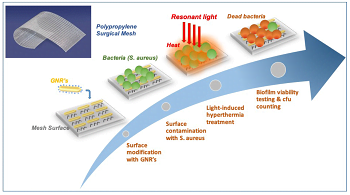Researchers have devised a novel technique that uses nanotechnology and photonics to dramatically improve the performance of medical meshes for surgical implants and help prevent antibiotic-resistant bacteria.
Institute of Photonic Sciences researchers have developed a medical mesh that features a surface of the mesh chemically modified to anchor millions of gold nanoparticles, which have been proven to efficiently convert light into heat at localized regions.
The technique of using gold nanoparticles in light-heat conversion processes had already been tested in cancer treatments in previous studies. For this particular case, knowing that more than 20 million hernia repair operations take place worldwide every year, the researchers believed this method could reduce the medical costs while eliminating the expensive and ineffective antibiotic treatments that are currently being employed.
In an in vitro experiment, the team coated the surgical mesh with millions of gold nanoparticles, uniformly spreading them over the entire structure. They tested the meshes to ensure the long-term stability of the particles, the nondegradation of the material, and the nondetachment or release of nanoparticles into the surrounding environment. They were able to observe a homogenous distribution of the nanoparticles over the structure using a scanning electron microscope.
 Once the modified mesh was ready, the researchers exposed it to S. aureus bacteria for 24 hours until they observed the formation of a biofilm on the surface. Subsequently, they began exposing the mesh to short intense pulses of near infrared light (800 nm) for 30 seconds to ensure thermal equilibrium was reached, before repeating this treatment 20 times with four seconds of rest intervals between each pulse.
Once the modified mesh was ready, the researchers exposed it to S. aureus bacteria for 24 hours until they observed the formation of a biofilm on the surface. Subsequently, they began exposing the mesh to short intense pulses of near infrared light (800 nm) for 30 seconds to ensure thermal equilibrium was reached, before repeating this treatment 20 times with four seconds of rest intervals between each pulse.
The researchers discovered that illuminating the mesh at the specific frequency would induce localized surface plasmon resonances in the nanoparticles — a mode that results in the efficient conversion of light into heat, burning the bacteria at the surface.
Secondly, by using a fluorescence confocal microscope, they saw how much of the bacteria had died or was still alive. For the bacteria that remained alive, they observed that the biofilm bacteria became planktonic cells, recovering their sensitivity or weakness toward antibiotic therapy and to immune system response.
For the dead bacteria, they observed that upon increasing the amount of light delivered to the surface of the mesh, the bacteria would lose their adherence and peel off the surface.
They also confirmed that operating at near infrared light ranges was completely compatible with in vivo settings, meaning that such a technique would most probably not damage the surrounding healthy tissue.
Finally, they repeated the treatment and confirmed that the recurrent heating of the mesh had not affected its conversion efficiency capabilities.
Romain Quidant, one of the study’s authors, said the discovery has the potential to change the way surgeries are performed, as well as the way patients recover from surgery.
“The results of this study have paved the way toward using plasmon nanotechnologies to prevent the formation of bacterial biofilm at the surface of surgical implants,” he said. “There are still several issues that need to be addressed, but it is important to emphasize that such a technique will indeed signify a radical change in operation procedures and further patient postrecovery.”
The research was published in Nano Letters (https//pubs.acs.org/doi/abs/10.1021/acs.nanolett.9b00187?af=R).